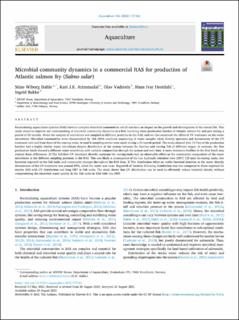| dc.contributor.author | Dahle, Stine Veronica Wiborg | |
| dc.contributor.author | Attramadal, Kari | |
| dc.contributor.author | Vadstein, Olav | |
| dc.contributor.author | Hestdahl, Hans Ivar | |
| dc.contributor.author | Bakke, Ingrid | |
| dc.date.accessioned | 2021-10-18T08:53:03Z | |
| dc.date.available | 2021-10-18T08:53:03Z | |
| dc.date.created | 2021-10-15T13:01:38Z | |
| dc.date.issued | 2021 | |
| dc.identifier.citation | Aquaculture. 2022, 546 (737382), . | en_US |
| dc.identifier.issn | 0044-8486 | |
| dc.identifier.uri | https://hdl.handle.net/11250/2823597 | |
| dc.description.abstract | Recirculating aquaculture systems (RAS) harbour complex microbial communities which can have an impact on the growth and development of the reared fish. This study aimed to improve our understanding of microbial community dynamics in a RAS involving three production batches of Atlantic salmon fry and parr during a period of 20 months. Water for analysis of microbiota was sampled at different positions in the RAS, and we also examined the effect of UV treatment on the water microbiota. Microbial communities were characterized by 16S rDNA amplicon sequencing of water samples taken directly upstream and downstream of the UV treatment unit and from three of the rearing tanks. In total 6 sampling events were made during a 20-month period. The study showed that: 1) Two of the production batches had a highly similar water microbiota despite disinfection of the system between the batches and rearing fish of different stages. In contrast, the first production batch showed a different water microbiota with variable composition through the system and over time. A more immature biofilter in the first batch may explain these differences. 2) The full-flow UV treatment directly upstream the rearing tanks had no observable effect on the community composition of the water microbiota in the different sampling positions in the RAS. This was likely a consequence of the low hydraulic retention time (HRT) (23 min) in rearing tanks, low bacterial regrowth in the fish tanks and community changes throughout the RAS loop. 3) The disinfection effect on viable bacterial densities in the water directly downstream of the UV treatment was around 89%, when the water was clear. Regrowth of bacteria following disinfection was low compared to those reported for marine RAS with UV disinfection and long HRT in fish tanks. The study shows that UV disinfection can be used to efficiently reduce bacterial density without compromising the microbial water quality in the fish tanks in RAS with low HRT. | en_US |
| dc.language.iso | eng | en_US |
| dc.publisher | Elsevier | en_US |
| dc.rights | Navngivelse 4.0 Internasjonal | * |
| dc.rights.uri | http://creativecommons.org/licenses/by/4.0/deed.no | * |
| dc.title | Microbial community dynamics in a commercial RAS for production of Atlantic salmon fry (Salmo salar) | en_US |
| dc.type | Peer reviewed | en_US |
| dc.type | Journal article | en_US |
| dc.description.version | publishedVersion | en_US |
| dc.rights.holder | © 2021 The Authors. Published by Elsevier B.V. This is an open access article under the CC BY license | en_US |
| dc.source.pagenumber | 9 | en_US |
| dc.source.volume | 546 | en_US |
| dc.source.journal | Aquaculture | en_US |
| dc.identifier.doi | 10.1016/j.aquaculture.2021.737382 | |
| dc.identifier.cristin | 1946215 | |
| dc.source.articlenumber | 737382 | en_US |
| cristin.ispublished | true | |
| cristin.fulltext | original | |
| cristin.qualitycode | 2 | |

